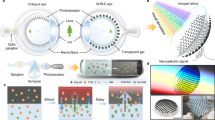Abstract
Loss of cone function in the central retina is a pivotal event in the development of severe vision impairment for many prevalent blinding diseases. Complete achromatopsia is a genetic defect resulting in cone vision loss in 1 in 30,000 individuals. Using adeno-associated virus (AAV) gene therapy, we show that it is possible to target cones and rescue both the cone-mediated electroretinogram response and visual acuity in the Gnat2cpfl3 mouse model of achromatopsia.
This is a preview of subscription content, access via your institution
Access options
Subscribe to this journal
Receive 12 print issues and online access
$209.00 per year
only $17.42 per issue
Buy this article
- Purchase on Springer Link
- Instant access to full article PDF
Prices may be subject to local taxes which are calculated during checkout


Similar content being viewed by others
References
Kohl, S. et al. Eur. J. Hum. Genet. 13, 302–308 (2005).
Kohl, S. et al. Am. J. Hum. Genet. 71, 422–425 (2002).
Johnson, S. et al. J. Med. Genet. 41, e20 (2004).
Chang, B. et al. Invest. Ophthalmol. Vis. Sci. 47, 5017–5021 (2006).
Deeb, S.S. Vis. Neurosci. 21, 191–196 (2004).
Wang, Y. et al. Neuron 9, 429–440 (1992).
Shaaban, S.A. et al. Invest Ophthalmol. Vis. Sci. 39, 1036–1043 (1998).
Nathans, J. et al. Science 245, 831–838 (1989).
Smallwood, P.M., Wang, Y. & Nathans, J. Proc. Natl. Acad. Sci. USA 99, 1008–1011 (2002).
Roca, A., Shin, K.J., Liu, X., Simon, M.I. & Chen, J. Neuroscience 129, 779–790 (2004).
Douglas, R.M. et al. Vis. Neurosci. 22, 677–684 (2005).
Umino, Y. et al. Proc. Natl. Acad. Sci. USA 103, 19541–19545 (2006).
Zhu, X. et al. Mol. Vis. 8, 462–471 (2002).
Acknowledgements
The authors thank J. Nathans (Johns Hopkins University-Howard Hughes Medical Institute) for providing the pR2.1-LacZ plasmid; C.M. Craft (Mary D. Allen Laboratories-University of Southern California Keck School of Medicine) for providing mouse cone arrestin polyclonal antibody (Luminaire Junior, mCAR/LUMIj); V. Chiodo, T. Doyle, M. Ding, I. Elder, R. Hafler, J. Pan, D. Smith and S.E. Boye for technical assistance; and G. Schultz and A. Lewin for comments on the manuscript. This research is supported by the US National Institutes of Health (EY011123, EY008571 and NS36302 to W.W.H.; EY00667 to R.B.B.; EY007758 to B.C.; and EY017246 to D.E.), the Foundation for Fighting Blindness, the Juvenile Diabetes Research Foundation, the Macula Vision Research Foundation, the Lions of Central New York, Research to Prevent Blindness, Fight for Sight and NASA. J.J.A. is supported by a US National Institutes of Health National Eye Institute training grant (EY007132).
Author information
Authors and Affiliations
Contributions
J.J.A. contributed to the design, execution and analysis of all of the experiments, and to manuscript writing. Y.U. contributed to the design and analysis of the behavioral tests. D.E. contributed to the execution and analysis of behavioral and paired-flash ERG tests. B.C. identified and characterized the Gnat2cpfl3 mutation. S.H.M. and A.M.T. performed the subretinal injections. Q.L. contributed to the AAV-PR2.1 promoter studies. N.L.H. contributed to the characterization of the Gnat2cpfl3 mouse. J.P. contributed to establishing the mouse colony. R.B.B. contributed to the implementation of behavioral and paired-flash ERG techniques. W.W.H. contributed to the design and analysis of all the experiments, and to manuscript writing.
Corresponding author
Ethics declarations
Competing interests
W.W.H. and the University of Florida have a financial interest in the use of rAAV therapies, and own equity in a company (AGTC Inc.) that might, in the future, commercialize some aspects of this work. All remaining authors declare that they have no competing financial interests.
Supplementary information
Rights and permissions
About this article
Cite this article
Alexander, J., Umino, Y., Everhart, D. et al. Restoration of cone vision in a mouse model of achromatopsia. Nat Med 13, 685–687 (2007). https://doi.org/10.1038/nm1596
Received:
Accepted:
Published:
Issue Date:
DOI: https://doi.org/10.1038/nm1596
This article is cited by
-
Two-dimensional biocompatible plasmonic contact lenses for color blindness correction
Scientific Reports (2022)
-
Achromatopsia: Genetics and Gene Therapy
Molecular Diagnosis & Therapy (2022)
-
Gene therapy in color vision deficiency: a review
International Ophthalmology (2021)
-
Focused Update on AAV-Based Gene Therapy Clinical Trials for Inherited Retinal Degeneration
BioDrugs (2020)
-
Pharmaceutical Development of AAV-Based Gene Therapy Products for the Eye
Pharmaceutical Research (2019)



